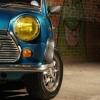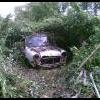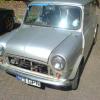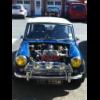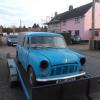'67 Morris Super De-Luxe
#31

Posted 05 August 2015 - 08:01 PM
#32

Posted 05 August 2015 - 08:17 PM
Coming along nicely there Tupers. ![]()
#33

Posted 06 August 2015 - 07:09 AM
Great work, very nice reference for my MK2 as I was thinking of doing the floor in the same way.
#34

Posted 09 August 2015 - 08:12 PM
Thanks guys I'm glad you're enjoying it.
Being the sort of person that likes to salvage part where possible I thought I'd repair the original seat crossmember as the only really damage to was on the front RH face.
After making a card template I tranfered the shape onto some steel and bent it up. The two angled flanges were done by clamping the steel under a piece of angle iron and gently hammering them up with a panel hammer.
Before it went on the captive nuts were added to the back. You can also see the crossmember cut out and the top edge joggled for a nice strong joint.
Clamped up for final check of the fit.
As per the usual I welded it up, linished down the welds and then ran the DA over it.
With the crossmember ready to go on I painted the area it would cover before getting the clamps out.
After test fitting it and adding a few clicos to hold it in a place I span the body on its side to plug weld the crossmember in from underneath. I've found this method makes welding and cleaning up simpler.
The jacking points have also been added with a few additional seam welds to make sure they're strong.
Here it is from the inside. Nothing special really but nice to see one more piece back in.
I've got a little cleaning up to do on the under side and I can get the body onto my frame and start on the inner wings and front end panels.
#35

Posted 09 August 2015 - 10:19 PM
#36

Posted 11 August 2015 - 08:08 PM
I wasn't sure if I was going to weld on the sills on before I took the shell of the spit but decided to after a bit of thought and my god am I glad I did.
I think welding these on took about a 10th of the time it would with the car the other way around.
It seemed logical to clean them up while they were easy to get to. I love the smell of fresh sills in the morning.
Now that the floor work is done it's onto the frame so I can work on the front end.
After many spot welds were drilled and a bit of careful air sawing the flitch is loose.
Just as one part of the car's looking good another part comes out. Fortunately I've become quite familiar with replacing flitches.
#37

Posted 11 August 2015 - 08:28 PM
I agree with you on the ease of outer sill welding with the car on it's side.
I haven't done one bit of upside down welding since i started mine
#38

Posted 13 August 2015 - 07:26 PM
While checking over the front end I noticed how both of the crossmember strengtheners had popped out due to rust behind them so decided to remove them.
Both side came off fairly easily as there are only 10 spot welds on each side to drill out. I also removed the remainder of the RH flitch and all of the LH flitch.
The original flitch gussets were pretty nasty at the bottom and needed some attention. It would have been quick to replace them entirely but I thought I'd use the bottom half of the MK3 style gussets that came on the heritage flitches to repair the originals.
It was a simple case of cutting away the rot, trimming the new piece and lining it up. I also added the hole as it's not present on the new panels
The RH gusset went through the same procedure but with slightly different cuts.
Seen as there's a big hole in the car once more I should probably get the new panels ready to go in.
I started by removing the MK3 style gusset and wiper motor indent.
In the past I've cut a crescent moon shaped section out around the MK3 heater intake lump but this time I decided to slit the edge and then planished it smooth before trimming off the excess and welding it up.
Filling the hole left by the wiper indent was a simple case out making a new section with a slight bend to match the flitch and then welding it in.
More of the same welding, linishing and DAing and it's done.
There was also a nice surprise waiting for me at lunch in the form of a fantastic pair of M-Machine A-panels. They should simplify the alignment to the car make for a tidier job when it come to fitting.
Lastly for this evening, they say you learn something new everyday and today I learnt than a Mini bulkhead is perfectly shaped for holding all of my air tools.
#39

Posted 13 August 2015 - 10:19 PM
#40

Posted 13 August 2015 - 10:23 PM
I don't know if it just me but there is something really satisfying about modifying later panels to suit earlier cars.
I got enormous pleasure deleting all of the extra holes and fixing points from my new inner wing to match the original.
Superb as usual!
Ben
#41

Posted 14 August 2015 - 07:53 AM
Cheers james
#42

Posted 14 August 2015 - 08:19 AM
JohnR
#43

Posted 14 August 2015 - 01:02 PM
Great work
#44

Posted 14 August 2015 - 07:04 PM
Those m machine a panel sections looking really good are those both sides of the a panel? So means you can just weld to the pillar and door post? Never seen those before?
You basically cut the old panel off at the step sill and A-post and then weld the new one rather just replacing the very outermost face of it. I'm not sure how long they've been making them but I've only found about them recently.
The first thing on the agenda for today was welding the crossmember strengtheners back in. This is where using spot weld drill bits comes in handy as all the parts already have the perfect size holes in them for plug welding.
Next up was rectifying the not uncommon sight of a snapped engine steady bar bracket.
I'm not entirely sure how this happened considering the car was originally an 850 auto and would have bairly had enough power to pull the skin off of cold rice pudding.
A bit of grinding and few beefy plug welds latter and the new one's on. Hopefully it will last a little longer than the original.
Moving slightly higher up on the front end there was a quite a heavily holed and pitted area on the top RH side of the bulkhead.
I started out by making a paper template of the various folds and creases on the panel before transferring it to steel.
I used a block of pine and a few different sized blunt chisels to beat the panel into shape and got it clamped up to check the fit.
As the panel was slightly larger than I had original planned I also added the indent for the tab that holds the wiring loom.
Then it got welded in.
A little linishing and some gentle planishing and it looks like this. I also made a new loom tab and plug welded it on.
On closer inspection the RH inner A-post also looked quite nasty so I decided it needed to go.
It's now out of the way and I'll get the new one in before the flitch goes on.
#45

Posted 14 August 2015 - 07:18 PM
Keep up the good work as it keeps me motivated to do mine ...: o)
Cheers James
3 user(s) are reading this topic
0 members, 3 guests, 0 anonymous users



